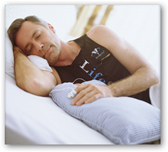I keep telling everyone who reads here that a lot of this stuff is here or very close to being here today and to be ready and be alert. When you spend time with companies like Cook Medical and Cambridge Consultants, you get a good idea of where all of this is going, and it’s moving fast! As always, I  like a good implementation as you can’t just throw devices at patients and doctors in a sink or swim situation and that’s why we have “participatory sensing” studies going on to make sure the rest of the process is set in place before hitting the “on” button.
like a good implementation as you can’t just throw devices at patients and doctors in a sink or swim situation and that’s why we have “participatory sensing” studies going on to make sure the rest of the process is set in place before hitting the “on” button.
A few examples from the past here, Best Buy has announced they will be supplying “Muve Gruve” devices for their employees to wear, this is one of those devices that records activity and reports data. Capsule Technologies supplies many of the software drivers that make these things work. The FDA may someday have to approve your cell phone.
Wireless Healthcare Medical Devices and the FDA – The Reasons They Are Slow to Come to Terms
The Pill Bottle That Talks To Your Cell Phone, Creates Data Reports and More…
And you might be swallowing your sensor as well as wearing it:
Proteus’ Raisin technology runs on an electric charge generated by the patient’s stomach acid. The charge is detected through the patient’s body by a sensing patch on the patient’s skin. The patch records the time and date that the pill is digested and also measures some vitals like heart rate, activity and respiratory patterns. The information is then sent to the patient’s mobile phone and then onto the internet for caregivers to review and analyze.
Someday you might be your own network and wear a power supply for all these devices.
Implantable Devices Getting Wireless External Power Supplies – Bionic Man/Woman

I did a summary not too long ago on many of the devices I have written about here, but if you want to see more, use that 2nd search box above and there’s more where this came from.
Wireless Monitoring With Medical Devices – There are Many Posts About These at the Medical Quack
If you participate in clinical trials, you might be wearing a Bluetooth and Zigbee wireless shirt. They are out there and moving forward.
LifeShirt Has Upgrade Coming Out With Bluetooth and Zigbee Wireless – A Shirt that Transmits Health Data
I have talked about devices, well now let’s enter the wearables. If you like your LifeShirt enough you can even sleep with it. Actually the shirt records data while you sleep so there is a purpose other than maybe just liking the fit. Actually the data collected can render information related to diagnosing and treating sleep apnea. Pharmaceutical companies are also using the shirt to help collect data during clinical  trials. Does this mean I’ll have a garment to reboot? (grin)
trials. Does this mean I’ll have a garment to reboot? (grin)
I have reported on some interesting devices, there’s a bra that will check your heart rate too, good for the gals, but maybe not of interest for the men.
Of course there is the exotic Blue Tooth Inhaler that I reference quite a bit here as well. Why a Bluetooth inhaler you might ask, the answer is compliance as it talks to a phone and records and send data. Watch the video from Cambridge Consultants and you can see the software and the whole thing set up ready to go, even to report to insurance companies which of course we are not supposed to do here in the US. Keep in mind the video was made in the UK. This is also an area where we need clarity too on perhaps in the future claims not being paid due to negligible non compliance with data trails to show a few mistakes, as we know how insurers use their algorithms to calculate and “score” our existence. Remember United makes more money today from technology than they do from policies via their Ingenix data division.
If you sign some type of a waiver though for use with biometric monitoring though through an employer or health plan, ask where the data is going and who sees is. I think all of these devices when used in patient care should go through a PHR Gateway that the patient controls, otherwise you lose control and can’t cut if off if you wanted too. If you are the gatekeeper of the first stop of transmitting data, then you are in control, so I just think it’s really a good idea to read up on some of this before it one day hits you in the face and you have no clue as to what is going on.
I do think too that our Congress should be active participants and just try some of these out so they know what participatory sensing is. Could members of Congress stand to be sitting in a lawmaking meeting and get texted while on the floor to start moving around more, that they are not getting enough exercise and be signaled to answer the “wellness coach” as to why they are not being compliant with a time limit set for responses before they are bugged again with more messages and a buzzing device?
I would like to see that picture with devices buzzing members of Congress while they are trying to concentrate, but again to understand some of this participation and education is needed, otherwise you get bad implementations with exactly that happening, a patient that is needled to death about moving around when a workable participatory plan is not in place. Let’s needle Congress so they understand what is evolving here so they can be aware and hopefully put some laws out there to protect some of the potential illegal activity that will go on with some of this and be ahead of the game.
I don’t always agree with all technology but I know I can’t stop progress and need to learn to be ahead of the game if I can and that is the reason I post about such items here and it may make some uncomfortable to read about some of this, and I apologize for that fact, but if its worth anything it makes me uneasy too with some of what I see too. I’m only the piano player and not the creator just trying to bring around an educational awareness and perhaps drag a few out of “technology denial” in the process. BD
Technology innovation is a leading driver in making any industry prosper. According to IEEE, the world’s largest technical professional association, this rings true especially in the field of healthcare. With over $27 billon spent each year in healthcare research and development globally, technology is playing an increasingly larger role in changing the way we prevent, diagnose and treat patients.
Technology has been utilized in healthcare on several fronts, from electronic patient medical records and monitors within the operating room, to the newer fields of telemedicine and robotic surgery and now wearable monitoring devices. This year, the Computing Community Consortium (CCC), through a grant from the National Science Foundation, held workshops to create the CCC Robotics Roadmap, which identifies the future impact of robotics technology on the economic, social, and security needs of the nation, outlines the various scientific and technological challenges, and documents required R&D to address these challenges
Telemedicine, e-records, and wearable sensors: Medical tech’s growth spurt | R&D Mag




0 comments :
Post a Comment